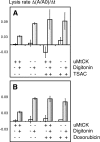Octameric mitochondrial creatine kinase induces and stabilizes contact sites between the inner and outer membrane
- PMID: 15294016
- PMCID: PMC1134715
- DOI: 10.1042/BJ20040386
Octameric mitochondrial creatine kinase induces and stabilizes contact sites between the inner and outer membrane
Abstract
We have investigated the role of the protein ubiquitous mitochondrial creatine kinase (uMtCK) in the formation and stabilization of inner and outer membrane contact sites. Using liver mitochondria isolated from transgenic mice, which, unlike control animals, express uMtCK in the liver, we found that the enzyme was associated with the mitochondrial membranes and, in addition, was located in membrane-coated matrix inclusions. In mitochondria isolated from uMtCK transgenic mice, the number of contact sites increased 3-fold compared with that observed in control mitochondria. Furthermore, uMtCK-containing mitochondria were more resistant to detergent-induced lysis than wild-type mitochondria. We conclude that octameric uMtCK induces the formation of mitochondrial contact sites, leading to membrane cross-linking and to an increased stability of the mitochondrial membrane architecture.
Figures




Similar articles
-
Mitochondrial boundary membrane contact sites in brain: points of hexokinase and creatine kinase location, and control of Ca2+ transport.Biochim Biophys Acta. 1988 Aug 17;935(1):87-102. doi: 10.1016/0005-2728(88)90111-9. Biochim Biophys Acta. 1988. PMID: 2457393
-
Contact site between inner and outer mitochondrial membrane: a dynamic microcompartment for creatine kinase activity.Biochim Biophys Acta. 1990 Jul 25;1018(2-3):225-8. doi: 10.1016/0005-2728(90)90254-2. Biochim Biophys Acta. 1990. PMID: 2393658
-
Further characterization of contact sites from mitochondria of different tissues: topology of peripheral kinases.Biochim Biophys Acta. 1989 Jun 6;981(2):213-25. doi: 10.1016/0005-2736(89)90031-x. Biochim Biophys Acta. 1989. PMID: 2543459
-
The structure of mitochondrial creatine kinase and its membrane binding properties.Mol Cell Biochem. 1994 Apr-May;133-134:115-23. doi: 10.1007/BF01267951. Mol Cell Biochem. 1994. PMID: 7808449 Review.
-
[Physiological role of the creatine kinase system and the problem of regulating the activity of mitochondrial creatine kinase].Nauchnye Doki Vyss Shkoly Biol Nauki. 1986;(9):5-14. Nauchnye Doki Vyss Shkoly Biol Nauki. 1986. PMID: 3535908 Review. Russian.
Cited by
-
Yeast mitochondrial interactosome model: metabolon membrane proteins complex involved in the channeling of ADP/ATP.Int J Mol Sci. 2012;13(2):1858-1885. doi: 10.3390/ijms13021858. Epub 2012 Feb 10. Int J Mol Sci. 2012. PMID: 22408429 Free PMC article. Review.
-
Unchanged mitochondrial organization and compartmentation of high-energy phosphates in creatine-deficient GAMT-/- mouse hearts.Am J Physiol Heart Circ Physiol. 2013 Aug 15;305(4):H506-20. doi: 10.1152/ajpheart.00919.2012. Epub 2013 Jun 21. Am J Physiol Heart Circ Physiol. 2013. PMID: 23792673 Free PMC article.
-
Proteolipid domains form in biomimetic and cardiac mitochondrial vesicles and are regulated by cardiolipin concentration but not monolyso-cardiolipin.J Biol Chem. 2018 Oct 12;293(41):15933-15946. doi: 10.1074/jbc.RA118.004948. Epub 2018 Aug 29. J Biol Chem. 2018. PMID: 30158245 Free PMC article.
-
Proteomic analysis of rat brain mitochondria following exposure to dopamine quinone: implications for Parkinson disease.Neurobiol Dis. 2008 Mar;29(3):477-89. doi: 10.1016/j.nbd.2007.11.007. Epub 2007 Nov 28. Neurobiol Dis. 2008. PMID: 18226537 Free PMC article.
-
The role of succinate and ROS in reperfusion injury - A critical appraisal.J Mol Cell Cardiol. 2017 Sep;110:1-14. doi: 10.1016/j.yjmcc.2017.06.016. Epub 2017 Jul 5. J Mol Cell Cardiol. 2017. PMID: 28689004 Free PMC article. Review.
References
-
- Wallimann T., Wyss M., Brdiczka D., Nicolay K., Eppenberger H. M. Intracellular compartmentation, structure and function of creatine kinase isoenzymes in tissues with high and fluctuating energy demands: the ‘phosphocreatine circuit’ for cellular energy homeostasis. Biochem. J. 1992;281:21–40. - PMC - PubMed
-
- Wyss M., Kaddurah-Daouk R. Creatine and creatinine metabolism. Physiol. Rev. 2000;80:1107–1213. - PubMed
-
- Wegmann G., Huber R., Zanolla E., Eppenberger H. M., Wallimann T. Differential expression and localization of brain-type and mitochondrial creatine kinase isoenzymes during development of the chicken retina: Mi-CK as a marker for differentiation of photoreceptor cells. Differentiation. 1991;46:77–87. - PubMed
-
- Dolder M., Walzel B., Speer O., Schlattner U., Wallimann T. Inhibition of the mitochondrial permeability transition by creatine kinase substrates: requirement for microcompartmentation. J. Biol. Chem. 2003;278:17760–17766. - PubMed
-
- Adams V., Bosch W., Schlegel J., Wallimann T., Brdiczka D. Further characterization of contact sites from mitochondria of different tissues: topology of peripheral kinases. Biochim. Biophys. Acta. 1989;981:213–225. - PubMed
Publication types
MeSH terms
Substances
Grants and funding
LinkOut - more resources
Full Text Sources
Molecular Biology Databases

